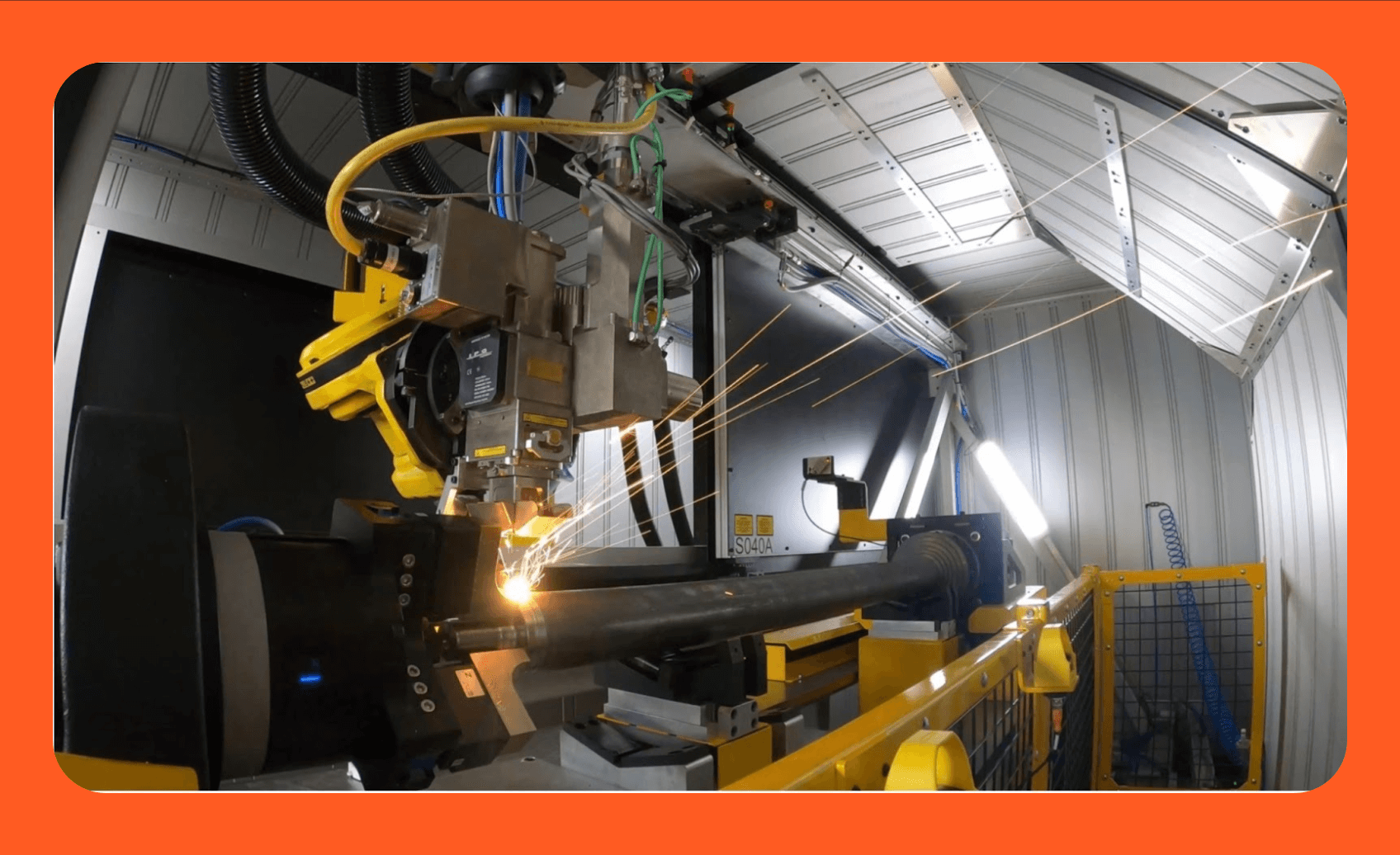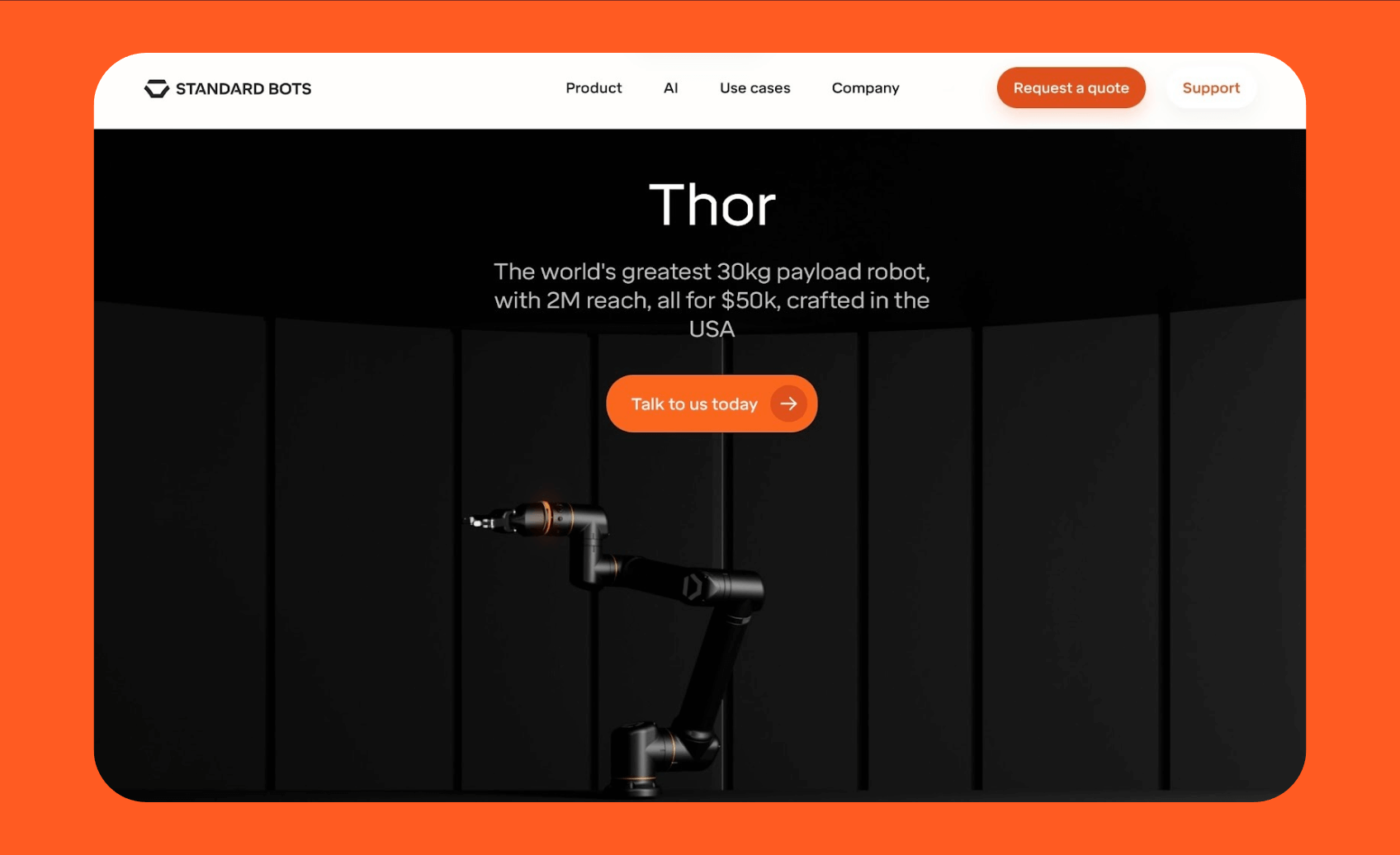Laser welding robots join metal using a concentrated beam of light that melts the material along a narrow path. This produces clean, precise seams with minimal heat-affected zones, reducing the risk of warping or discoloration.
In real-world production, laser welding often runs up to 10x faster than TIG or arc welding on comparable materials and thicknesses. This speed, combined with high repeatability and cleaner finishes, makes it a preferred choice for manufacturers focused on both throughput and part quality.
What is robotic laser welding?
Robotic laser welding is an automated process that combines the high precision of a laser with the flexibility of a robotic arm to join materials. Instead of generating heat through an electric arc, the system directs a concentrated laser beam to melt and fuse metals along precise paths.
The laser itself can come from different sources, such as fiber, diode, or CO2, each suited to specific materials and thicknesses. The robot positions the laser with sub-millimeter accuracy, ensuring consistent welds even on complex or delicate components.
By combining robotic control with laser precision, robot laser welding achieves exceptional repeatability, minimal distortion, and high-speed operation. This makes laser welding robots a top choice in sectors where quality, appearance, and efficiency are equally important.
Key features of laser welding robots
Key features of laser welding robots include high speed, minimal heat impact, automation-ready integration, real-time quality control, and high precision.
- High speed: On comparable joints, laser welding reaches 10 times the welding speed of TIG/arc processes. Robots maintain constant travel speed and beam focus, while keeping quality consistent from one part to the next.
- Minimal heat-affected zone: Concentrating energy into a tiny spot keeps the surrounding metal cooler, which reduces warping and post-weld rework. Manufacturers get a smoother finish and cleaner appearance straight from the cell.
- Automation-ready design: Modern laser welding robots connect easily with conveyors, clamps, and quality inspection systems. This makes them ideal for continuous, hands-free operation or integration into multi-step automated lines.
- Real-time quality control: Advanced sensors track temperature, penetration depth, and alignment as the weld forms. These systems automatically adjust laser power or speed to maintain uniform quality.
- High precision: Laser welders deliver sub-millimeter accuracy, allowing them to handle delicate geometries and thin materials without distortion. This level of control is particularly valuable in industries such as automotive and electronics, where even minor deviations can lead to rework or failure.
How laser welding robots work
Laser welding robots work by combining a high-energy laser source with robotic precision to create accurate, repeatable welds.
The process follows a simple but tightly controlled sequence:
- Laser generation: Energy from the power source is converted into a focused laser beam.
- Beam delivery: Mirrors or fiber cables guide that beam to the robot’s weld head.
- Robot movement: The controller drives the robot along a programmed path while the laser melts and fuses the joint.
- Melt and fusion: The concentrated light melts the metal edges, which quickly fuse as the material cools.
- Monitoring and control: Sensors track penetration depth, temperature, and alignment in real time to maintain consistent weld quality.
Because the beam is contact-free, there’s no electrode wear or mechanical pressure. This enables robotic laser welding to produce extremely clean seams at high speed while maintaining a small heat-affected zone.
Advantages over traditional welding
Compared to traditional welding, robotic laser welding offers faster operation, tighter precision, and lower ongoing costs. Traditional methods depend heavily on operator skill and involve more heat, more distortion, and higher consumable costs. In contrast, robotic laser welding delivers stable, repeatable results and is far easier to automate.
Limitations and considerations
Limitations and considerations include necessary safety protocols, higher upfront costs, tight part-tolerance requirements, strict surface-preparation needs, and scale considerations.
- Strict safety measures: Cells must comply with ISO 11553 for laser processing machines and ANSI Z136 for safe laser use, with guarding, interlocks, PPE, and trained LSOs.
- Higher initial investment: Laser welding robots are more expensive than conventional MIG or TIG systems. Complete setups can range from $70,000 to $250,000+, depending on power, optics, robot, and integration scope.
- Tight part tolerances: The laser beam is extremely focused, leaving little room for misalignment. Any gap or uneven edge can lead to incomplete welds. Precision fixturing and camera-based alignment systems are often used to ensure consistency.
- Surface preparation: Metals must be clean and free of oil, rust, or coatings before welding. Even small impurities can cause spatter or weak fusion. Many manufacturers add laser or plasma pre-cleaning stages to maintain weld quality.
- ROI and scale considerations: The cost-effectiveness of laser-welding robots increases at medium to high production volumes or in precision-critical applications. Smaller workshops typically start with cobot-based laser welders for greater flexibility and lower entry cost.
By addressing these points early, manufacturers can ensure their laser welding robots deliver maximum reliability and return on investment.
Real-world examples
Real-world examples of robotic laser welding include automotive, aerospace, medical, and heavy fabrication sectors.
Automotive and EV battery manufacturing

Laser welding robots are widely used in assembling battery modules, packs, and cooling plates for electric vehicles. AMRC demonstrated laser tab-to-busbar welding for Al, Cu, and Ni-plated Cu in EV battery joins, showing strong joints under appropriate parameters.
Phoenix Laser Solutions built an automated laser cell to join copper busbars to battery tabs, improving consistency and enabling production runs. Automotive programs specify tight flatness and leak-tightness for battery trays and pack enclosures, which is why producers deploy laser welding with inline monitoring for repeatability.
Precision and small-component manufacturing

Integrators such as Photon Automation build robotic laser systems for medical devices and battery assemblies that demand microscale precision. These systems can create smooth, burr-free joints between small metal parts without overheating surrounding areas.
TQC Ltd engineered a robotic laser fabrication cell that forms and welds metal seal rings using a six-axis robot and in-cell stations. The system improved production repeatability while reducing manual rework.
Heavy-duty and high-power fabrication

Industrial manufacturers are now using laser welding robots for large, high-strength components. In a verified case from Automate.org, a 10 kW fiber laser integrated with a six-axis robot was deployed to weld hydraulic cylinder tubes.
The setup achieved deep, full-penetration welds with minimal distortion and full process monitoring. It demonstrates how robotic laser welding can outperform traditional submerged or arc welding on thicker materials.
Aerospace and medical manufacturing
Aerospace suppliers use robotic laser welding to join titanium and nickel-alloy turbine parts that require extremely tight tolerances. Robotic laser welding has become the preferred method for titanium and aluminum alloys because it minimizes heat distortion and reduces rework.
In medical manufacturing, laser welding robots are used to join miniature implants, catheters, and surgical instruments. Because the beam never contacts the material directly, welds are contamination-free and meet ISO 13485 traceability requirements.
Where Standard Bots fit

At Standard Bots, the focus is on making high-precision automation practical for every manufacturer, not just global enterprises. Laser welding is one area where the company’s full-stack approach, building both hardware and software in-house, creates a clear advantage.

- Standard Bots Core: A compact six-axis cobot designed for high-precision applications like laser welding, CNC tending, and inspection. It offers ±0.025 mm repeatability with an 18 kg payload, ideal for any manufacturer upgrading from manual systems.
- Standard Bots Thor: A heavier-duty robot with a 30 kg payload that delivers the same level of accuracy and flexibility. Thor is best suited for advanced automation setups that require greater reach and load capacity.

Because motion control, vision, and safety systems are developed together, Standard Bots robots integrate easily with laser heads and optics from any major provider. Built-in collision detection and compliance with safety standards make them safe and reliable.
Complete welding setups with Standard Bots Core include the industrial MIG kit and accessories. These systems are designed for quick deployment, letting manufacturers start production in days rather than months.
Summing up
Laser welding robots combine speed, precision, and consistency in ways manual welding simply can’t match. From EV battery assemblies to medical instruments, they deliver strong, distortion-free joints while cutting waste and post-processing time.
As costs continue to fall and integration becomes simpler, robotic laser welding is no longer a niche technology reserved for large factories. It’s now a practical upgrade for any operation that values accuracy, traceability, and throughput.
For manufacturers ready to take the next step, the path forward is clear, and Standard Bots is helping make that transition faster than ever.
Next steps with Standard Bots’ robotic solutions
Looking to upgrade your automation game? Standard Bots Thor is built for big jobs, while Core is the perfect six-axis cobot addition to any automation setup, delivering unbeatable precision and flexibility.
- Affordable and adaptable: Core costs $37k. Thor lists at $49.5k. Get high-precision automation at half the cost of comparable robots.
- Perfected precision: With a repeatability of ±0.025 mm, both Core and Thor handle even the most delicate tasks.
- Real collaborative power: Core’s 18 kg payload conquers demanding palletizing jobs, and Thor’s 30 kg payload takes on heavy-duty operations.
- No-code simplicity: Our intuitive, no-code app makes it easy to teach Standard Bots robots to do everyday tasks. So, Core and Thor integrate smoothly with CNC and laser welding operations for advanced automation.
- AI-driven models: For complex, high-variance, and unpredictable tasks that are otherwise impossible to automate today, Standard Bots robots learn through our AI-driven vision-to-action models, similar to how full self-driving works.
- Safety-first design: Machine vision and collision detection mean Core and Thor work safely alongside human operators.
Schedule your on-site demo with our engineers today and see how Standard Bots Core and Thor can bring AI-powered greatness to your shop floor.
FAQs
1. What is robotic laser welding?
Robotic laser welding uses automated robots equipped with laser sources to melt and fuse metals along programmed paths. The process delivers clean, precise, high-speed welds with minimal distortion, ideal for industries that require consistent, high-quality joints.
2. How do laser welding robots differ from conventional welders?
Laser welding robots differ from conventional welders by using a focused laser beam instead of an electric arc. This non-contact method reduces heat distortion, increases speed, and eliminates the need for filler wire or shielding gas in many cases.
3. What industries use laser welding robots?
Industries that use laser welding robots include automotive, EV battery production, aerospace, electronics, and medical manufacturing. These sectors depend on the precision, speed, and consistency that robotic laser welding provides.
4. What are the benefits of robotic laser welding?
The benefits of robotic laser welding include high precision, faster weld speeds, minimal heat-affected zones, reduced consumables, and easy integration with automation. Together, these advantages lead to stronger joints, less rework, and higher productivity.
5. Are laser welding robots suitable for small manufacturers?
Laser welding robots are suitable for small manufacturers thanks to compact, cobot-based systems that offer intuitive setup, smaller footprints, and quick ROI. These systems make high-precision automation accessible even for mid-sized fabrication shops.
6. What safety measures are required for robot laser welding?
Safety measures for robot laser welding include using certified laser enclosures, interlocks, and protective eyewear rated for the laser class. Compliance with ISO 11553 and ANSI Z136 ensures safe operation of all robotic laser systems.
brighter future
Join thousands of creators
receiving our weekly articles.







%2520(1).png)
.png)

